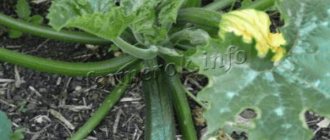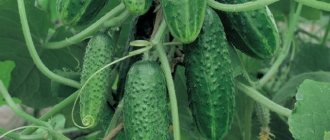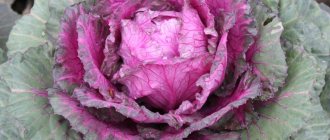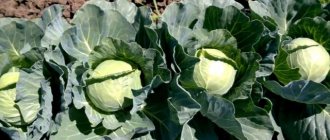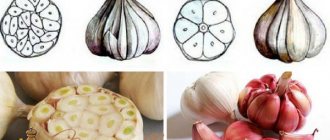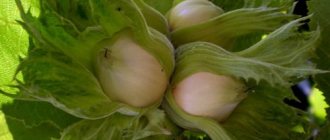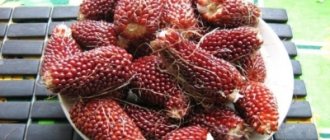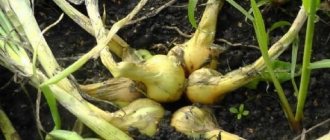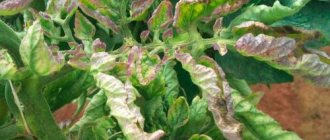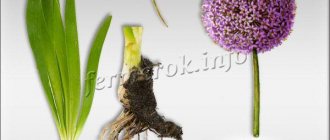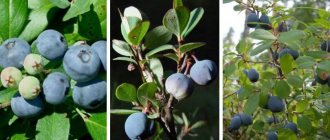Zolotinka zucchini squash has been grown in Russia since the distant 80s of the 20th century. This is one of the very first yellow squash varieties developed. The advantage of this variety is the high yield of bright yellow fruits that do not lose their marketable quality for a long time.
Features of Zolotinka variety zucchini
This variety is early ripening. Its growing season takes approximately 47-50 days. Considering that this is a bush plant, then as it ripens, up to 15 fruits weighing an average of 0.5 kg can be removed from the bush.
Zolotinka zucchini is grown under film or in open ground.
The fruits, which are 15 cm long, are distinguished by a dense, smooth skin and orange or yellow-orange sweet, crispy pulp. Dry matter in their juice is up to 8%, sugar – 4.2%. Productivity – 25-35 t/ha.
Zolotinka variety zucchini has beneficial properties and is easy to care for.
Thanks to the female type of flowers, Zolotinka squash bears fruit for a very long time and abundantly. Zucchini acquires its bright yellow color as it ripens.
Tip #1. It is best to eat fruits up to 400 grams. Larger specimens lose their taste.
In the first half of the growing season, the plants are compact, in the second half they develop small vines, which does not affect the number of fruits. The Zolotinka variety is ideal for feeding children from 1 to 7 years old. The fruit pulp does not lose density during canning.
Features of care
Zucchini is...
The Zolotinka variety is quite demanding on soil. Prefers a light, drained, fertile, neutral substrate. Does well on loamy soils. The soil must be heated. If the soil is acidic, peaty or heavy, clayey, plant growth slows down, shoots and fruits become smaller, and productivity decreases. To correct the situation, rotted manure, phosphorus-containing fertilizers, and wood ash are added to the soil. For better growth and fruiting, you can spray it with urea 2 times (1 tbsp per 10 liters of water). The period between spraying is 2 weeks.
Due to the fact that Zolotinka is an early ripening variety, it is not advisable to feed it with nitrate fertilizers. Otherwise, chemicals will accumulate in the fruit. Instead, compost is added to the planting hole.
Compost
The soil for zucchini should be constantly moist, without stagnant water. This is an important care condition for flowering and fruit formation. During drought, the ovaries may fall off. Water with warm water 1-2 times a week.
Need to know! If the petals remain on the ovaries after wilting, they must be carefully removed. Otherwise, the fruits may rot.
The variety is grown in areas where cruciferous, legume or nightshade plants used to grow. Root vegetables are also preferred among the predecessors. If zucchini is planted where squash plants used to grow, they can become infected with diseases of the previous plants.
Zolotinka zucchini is planted in open, sunny places. These spaces must be well heated and ventilated to prevent rotting.
Bush squashes, including zucchini, do not crop. The fruits of these plants are formed on the central stem. Due to its structure, namely its short stature, Zolotinka does not require a garter. Only an adult plant, when small lashes begin to form, may need additional support. It is better to remove the lower leaves, then the zucchini will be better ventilated.
When small vines begin to form, the squash may need additional support.
How to grow Zolotinka zucchini?
In order for zucchini to please you with a good harvest, you need to follow some rules for growing them:
- The landing site should be sunny.
- Zolotinka zucchini grows well in fertile or neutral soil. If it is acidic, then lime it and apply mineral and organic fertilizers.
- The best predecessors for zucchini are root vegetables, potatoes, and onions.
- The seeds are sown in the ground at the end of May, immediately after spring frosts. Zucchini is demanding on feeding area. Therefore, it is advisable that the distance between the bushes be at least a meter. Prepare the holes in advance. You can plant several seeds in each of them at once.
- After the first true leaves appear, thin out the seedlings: remove the weak ones. Leave one sprout in each hole. Moreover, it is better not to pull out the excess ones, but to cut them off at the root, so as not to damage the strong shoots. If this is not done, the plants will quickly stretch out, side shoots will be late to form, and flowering will occur later. After the fourth or fifth leaves appear, the bushes need to be covered a little with moist soil - this is necessary for the growth of adventitious roots.
Zolotinka is also grown for seedlings. This is done in early May. They are planted in the ground at the very beginning of June.
The harvest of this variety of zucchini can be obtained as early as early June. To do this, at the beginning of April you need to sow several seeds, one at a time, in peat humus cups with a nutritious soil mixture for seedlings. When the second true leaf appears, the seedlings should be planted under a film stretched over a bent reinforcement. In order for the zucchini to ventilate (they do not like stagnant, humid air), holes must be made in the film (500 holes per 1 sq./m at a distance of 10 mm from each other). This cover should be removed when the threat of frost has passed.
After the second leaf appears, zucchini needs to be fed
Varietal description
Zolotinka zucchini is a type of zucchini. It has a bright golden smooth skin, which becomes more contrasting when fully ripe.
The average weight of oval-shaped fruits is 0.5-1 kg, length - up to 15 cm. Zucchini pulp is orange or yellow-orange, sweet in taste, crispy in structure, and retains its original density when canned. The pulp contains a high proportion of sugar (about 4.2%) and solids (about 8%).
The variety is an early ripening variety, ripening in 47-50 days from the appearance of the first shoots.
A bush plant with a non-spreading leaf crown. Grows up to 0.45 in height. Capable of releasing lashes by the second half of the growing season, which does not have a significant effect on yield indicators. The foliage is light green, carved at the edges, with a characteristic pattern on the leaf blades in the form of light yellow or white fragments. There are no thorns on the stems and petioles, and there is no pubescence. The inflorescences are bright yellow, self-pollinating.
Zucchini care
Zolotinka zucchini is not picky in care:
- Immediately after sowing, the soil is mulched with cardboard or a piece of roofing felt - this will restrain the growth of grass and protect the root system of plants from heat shock. If necessary, use covering material.
- Remove the lower leaves, which are primarily affected by powdery mildew. In addition, the bush will be better ventilated after this.
- Water the plants regularly, loosen the soil and hill up.
- Apply mineral and organic fertilizers. As a rule, fertilizing begins after the second leaf.
- Be sure to carefully remove the remnants of petals located on the corolla of young ovaries. If they are not removed, then under the influence of moisture they will subsequently cause rot on the fruit.
- Zucchini is a self-pollinating plant. Therefore, in order to propagate the Zolotinka variety by seeds, they should be pollinated by hand. To do this, you need to isolate the buds of male and female flowers in the evening, tying them with gauze in several layers. When they bloom in the morning, you should use a cotton swab to transfer the pollen to the stigma of the pistils and tie the pollinated buds again.
According to all the rules of agricultural technology, there should be at least three feedings: during the flowering period and after.
Sowing and growing seedlings
Yellow zucchini seeds are sown after frost. The distance between the holes should be at least 60 cm. 2-3 seeds are placed in each hole. For better germination, cover material is used. Even before the sprouts sprout, the soil is mulched. After the seedlings appear, the plants are pruned, removing weak shoots.
When 4-5 true leaves are formed, the plants are carefully hilled up. Then the root system will grow stronger and become more powerful.
If you start growing seedlings in April, then in the first half of June you can already harvest. When planting, use peat cups with specialized soil for seedlings.
Seedlings in pots
Comparative characteristics of yellow-fruited zucchini varieties
Let's consider the description of popular yellow-fruited varieties of zucchini, including the Zolotinka variety.
| Variety name | Description and characteristics | Advantages and disadvantages | Ripening time and yield |
| Pear-shaped | The fruits are pear-shaped. Size approximately 23x13 cm. Weight 0.9-1.3 kg. Dark orange pulp is fragrant, sweet | Excellent for recycling. It is widely used in cooking. Fruits are stored for a long time | Early ripe fruitful variety |
| Golda | Golden-orange fruits are up to 40-50 cm long. Average weight is up to 2.5-3 kg | Resistant to diseases. Has an excellent presentation | Early ripening hybrid. Productivity 450–570 c/ha |
| Goldrush | The fruits are golden yellow. Their length is 20 cm. Weight is up to 210 g. The middle is creamy white, very tender. | Dutch hybrid. Suitable for fresh consumption and also for canning | Early ripening hybrid. Productivity 11.5 kg/sq. m |
| Yellowfruited | The bright yellow fruits are cylindrical in shape. Weight 0.8-0.9 kg. High sugar content | Quite resistant to powdery mildew | Early ripening zucchini with a yield of up to 20 kg/sq.m. m |
| Golden | The fruits weigh up to 1 kg. Very tasty | The variety is resistant to powdery mildew | Early ripening variety. Productivity 16-18 kg/sq. m |
| Helena | The fruits are golden yellow in color and are up to 20 cm long. Weight is up to 610 g. The pulp is yellow, very tender and tasty. | Sufficient resistance to bacteriosis and powdery mildew | Early ripening variety. Productivity 15.4–27.5 t/ha |
| Sunlight | The color of the fruit is yellow-golden. The diameter reaches 4-5 cm, length up to 18 cm. The pulp is dense and white. | Suitable for fresh consumption and canning | French early ripening hybrid. Productivity is high |
As you can see, Zolotinka has good taste characteristics, early ripening and disease resistance.
Zolotinka variety zucchini is one of the most popular
In addition, other varieties of yellow-fruited zucchini are also popular with vegetable growers: Banana, Yellow Stars, Atena Polka F1, Mary Gold F1, Pineapple, Peppy, Pinocchio, Shchedry Bogatyr, Tender Marshmallow and Lemonade Joe.
Characteristics of the variety
The yellow-fruited, early-ripening variety “Zolotinka” is deservedly popular among amateur gardeners and peasant farms. Zucchini is attractive due to its gastronomic qualities, exotic appearance and ease of care.
Productivity
Zucchini is a high-yielding variety. Zucchini fruits ripen quickly and are harvested on the twelfth day after flowering. If the harvest is not harvested in time, the fruits will outgrow and lose their taste. Therefore, during mass fruiting, it is recommended to harvest zucchini 2 times every 7 days.
Attention! The “Zolotinka” culture is thermophilic, seeds begin to germinate at 10–20 ˚С, growth stops at 8–12 g ˚С. If the temperature stays below 8 °C for a long time, the plant will die.
In favorable climatic conditions, subject to the rules of agricultural technology, up to 16 pieces are taken from one bush. zucchini. If the average weight of the fruit is 600 g, then the harvest is up to 8 kg per season. The collection begins in the first days of June in the southern regions and in the second half of the month for latitudes with a temperate climate. The optimal daytime temperature is 24–28 ˚С, night 18–22 ˚С. The culture is not suitable for Siberia and the Far East.
Area of application of fruits
Zucchini dishes are quick and easy to prepare. They are stewed, fried, stuffed. Zucchini is eaten raw in salads. Zucchini fruits are suitable for homemade preparations. They tolerate heat treatment and preservation well. Caviar or puree is made from the Zolotinka variety, which, having anti-allergic properties, is suitable for children up to one year old.
Resistance to diseases and pests
The hybrid variety was bred taking into account increased disease resistance. Apical bacteriosis affects the crop if the zucchini grows in a greenhouse in which the temperature is low and the humidity is high. Fungal infection of powdery mildew is a common disease among zucchini, but with proper agricultural practices the variety is not afraid. For prevention, the lower leaves are removed from the plant. To prevent rotting of the fruit, it is necessary to remove old flowers. Cases of anthracnose (the presence of brown spots on the leaves) in Zolotinka squash are rare. In general, it is a culture resistant to bacteria and fungi. To prevent garden pests from destroying zucchini, it is necessary to change the planting location once every 3 years.
Advantages and disadvantages of the variety
Zolotinka zucchini, according to reviews from vegetable growers who have been cultivating the crop for many years, has virtually no drawbacks. Characteristics of positive qualities include:
- the productivity of zucchini, since the ovaries are formed due to the dominant female flowers;
- early ripening with recommended care, even in temperate climates;
- the bush does not take up much space due to its compact shape;
- varietal crop allows you to independently collect material for planting;
- beneficial properties - they contain many vitamins and microelements;
- the taste is not fresh, slightly sweet;
- the variety is unpretentious in care;
- practically not affected by diseases and pests;
- well stored and transported;
- Zucchini is suitable for canning and eating raw.
The Zolotinka variety is recommended for making puree for children with allergies. Due to its properties to cleanse the body, it is used in cosmetology.
The disadvantage is the rapid overripening of the fruit. If the harvest is not harvested on time, zucchini grow up to 2 kg in weight, they have a hard skin, rough to the touch, and rough flesh. Such fruits are only suitable for feeding cattle or pigs.
Questions about growing Zolotinka zucchini
Question No. 1. Does the yield of zucchini depend on its color?
The yield of zucchini does not depend on color. Rather, it depends on whether it is a hybrid variety. And if it’s a hybrid, then what kind? New foreign hybrids, including dark green ones, are very productive today.
Question No. 2. Yellow zucchini grew in the garden bed. We don’t remember what seeds were sown. Can these zucchini be eaten?
There are many varieties of yellow squash. As a rule, they are all edible, have a thin crust and crispy, sweetish flesh. You can prepare caviar from them, they can be fried and even eaten raw. Suitable for canning and pickling. At the same time, the fruits do not change their amber color. Excellent jam is made from yellow-fruited zucchini - with lemon, grapes, cherry plum, and red currants.
Advantages and disadvantages of the variety
The clear advantages of zucchini are:
- high yield due to the large number of female flowers on the bush;
- rapid ripening of fruits even in areas with a temperate climate;
- compact plant size;
- the opportunity to obtain seeds from grown zucchini;
- rich, sweetish taste of the pulp;
- resistance to many pumpkin diseases;
- suitable for long-term storage and transportation;
- the product is useful for young children and adults;
- The fruits are versatile in cooking, as they are suitable for hot dishes, salads and canning.
Zolotinka's weaknesses include:
- the fruits quickly overripe, which is why their taste deteriorates, the pulp becomes fibrous, and the peel becomes thick;
- more suitable for warm regions; residents of the northern regions will have to use the seedling method to get a good harvest.
Typical mistakes when growing Zolotinka zucchini
We offer common mistakes gardeners make:
- The fruits do not set or the greens turn yellow and rot. Most likely, fertilization did not occur, or the weather is rainy and cold. Perhaps the plants are freezing, especially if the temperature at night is below +10-12 degrees. At night, plants need to be covered with lutrasil.
- Zucchini has an irregular shape (the end is pear-shaped). Plants lack potassium. You need to scatter ash on the damp soil (half a liter for each plant), or in the evening, spray the plants with a solution of Uniflor-bud (2 tsp/10 l of water).
- The tip of the zucchini is tapered and lighter in color. Nitrogen deficiency. It is necessary to feed the plants with an infusion of manure, or weeds, or bird droppings.
- The tips of large fruits rot. This indicates a lack of moisture. It is necessary to stop watering. Cut off the rotten part and burn the cut in a candle flame.
Rate the quality of the article. We want to be better for you:
Features of agricultural technology
The Zolotinka variety of zucchini is grown under a film covering in greenhouse conditions or in open soil using seedlings or non-seedling methods.
Basic cultivation rules:
- a well-lit place for planting vegetables;
- highly fertile land with neutral acidity, while the required level of acidity can be adjusted by adding limestone or wood ash to the soil;
- compliance with crop rotation and correct selection of predecessors; for zucchini, the best predecessors are potatoes and onions;
- sufficient distance between bushes, because Zolotina requires a significant space, the interval between plantings should be at least 1.0 m;
- planting in soil heated to 10˚C-15˚C, the plant stops developing when the indicators drop to 8˚C, and with long-term frosts below this limit value it dies.
Planting by seeds
Seedlings need to be thinned out
When planting zucchini seeds in greenhouse conditions or in open ground, 1.0-1.5 kg of compost and 3-5 seeds are placed in the holes at a time.
After the first leaves appear, the plantings are thinned out, leaving only one, the strongest, plant in each hole. In this case, excess shoots are not pulled out, but cut off at the root to avoid damage to the root system of a strong shoot.
In the absence of thinning of plantings, the seedlings will stretch upward, the lateral shoots will be delayed in development, which will subsequently affect the time of flowering and fruit formation.
When 4-5 leaves appear, the bushes are covered with moistened soil, which activates the growth and development of adventitious roots necessary for enhanced nutrition of the plant.
Germination of seedlings
To obtain an early harvest, the seedling planting method is chosen. Peat humus containers filled with substrate for growing seedlings are suitable for germinating seedlings.
They begin to sow from the first days of May. The time for transplanting into open soil is after 25-30 days, i.e. in early June, when 2 or more true leaves appear.
To avoid the death of sprouts due to sudden frosts, they are covered with a film cover. Zucchini does not tolerate stagnant moisture well, so holes are made in the film at a distance of 1 cm. This will avoid condensation accumulation. In conditions of established warm weather, the film coating is removed.
Further care
Caring for zucchini includes the basic activities that are necessary when cultivating vegetables.
Weeding
Removing weeds allows you to maintain a full supply of mineral nutrition for zucchini.
In the process of caring for vegetables, it is also necessary to remove the lower tier of foliage. This will ensure good ventilation, which is a preventive measure in the fight against powdery mildew.
The remaining petals on the corollas of young ovaries must be removed; after some time, under the influence of moisture, they begin to rot and cause rot to appear on young vegetables.
Watering
The regularity of watering Zolotinka is once every 5 days with preliminary loosening of the top layer of soil.
Feeding
At the flowering stage, a second feeding is carried out
The first fertilizing application occurs at the time the second leaf appears on the sprouts. Organic matter is recommended as a fertilizer at the initial stage. The second and third fertilizing with mineral complexes is carried out at the flowering stage and during the period of fruit formation, respectively.
Complexes containing a high percentage of nitrogen in the nitrate formation are avoided. It adversely affects the duration of subsequent storage of vegetables.
In case of delay in development and poor fruiting, the vegetable crop is fed with urea using the foliar method. Urea is diluted at the rate of 1 tbsp. for 10 liters of water. The plantings are sprayed at intervals of 10-15 days.
Pollination
To propagate the Zolotinki variety, zucchini are pollinated by hand, in the evening isolating the male and female buds by tying them with a thick layer of gauze. In the morning, pollen is transferred to the pistils using a cotton swab and the buds are again tied with gauze.
Bush zucchini - the best varieties
The form of zucchini in the form of small bushes is an excellent choice for modest summer cottages. They fit on just a couple of square meters and are able to provide an average family of 3 to 4 people with ripe fruits for the whole summer.
This variety comes in early and late ripening, Russian or foreign (Dutch) selection.
Growing bush zucchini in the garden - video
Zucchini "Aral F1"
The small bush was obtained artificially. Ripens early: already on the 45th day the fruits are ready for harvest. The hybrid feels great in any weather, and, what is especially important, the harvest does not suffer. Overgrown fruits are pear-shaped.
Sadko F1
An early ripening variety of zucchini. It is harvested 1.5 months after the sprouts appear. The fruit has a smooth white surface. A small ribbing can be seen near the stalk. The pulp is tender and juicy. It has a sweet taste. About 1.8 kg of zucchini is harvested from 1 m2, provided there is sufficient watering.
Photo of zucchini variety Sadko F1
Zucchini "Dinar F1"
Another early-ripening squash variety. Ripe fruits are harvested on the 42nd day after the seeds “hatch” and sprouts appear. The shape of the fruit is elongated. The skin is thin and smooth. The stalk has ribs. It has firm flesh and a sweet aftertaste.
Zucchini variety "Quand"
Kuand zucchini is distinguished by alternating dark and light stripes, forming a unique pattern on the fruit. This is a mid-season variety of zucchini. The first fruits are formed on the 57th day after the appearance of the first shoots. The skin of young zucchini is tender and thin, but as it matures it noticeably becomes coarser. The plant is weather resistant.
Golden
Rich yellow zucchini attracts attention because the color for this vegetable is truly unusual. Its pulp is so soft that it is suitable even for baby food (from the age of 7 months). Small bush with mostly female flowers. One zucchini weighs from 200 to 400 grams. It is perfectly stored in suitable conditions (up to 60 days).
On a note:
for permanent cultivation, preference is given to resistant varieties, which are distinguished by large bushes with large leaves. These varieties tolerate temperature changes well.
Features of cultivation
Zolotinka is a small-sized bush plant. It begins to produce the first lashes only in the second phase of development, but this does not in any way affect the number of fruits.
For good fruiting you need to follow some recommendations:
- the place where the zucchini will be planted should be light
- the soil is suitable both fertile and neutral
- follow the rules of planting and care
Landing
The Zolotinka variety of zucchini is best planted after onions, potatoes and other root vegetables.
There are two ways to plant: sow seeds in open ground (in April) or by seedlings (in late May or early summer).
In the second case, after a month the seedlings are planted in a permanent place. It is best to do this early in the morning. The bush is taken out along with the soil and placed in a hole watered with warm water. The seedling should be placed at a slight angle.
After planting, it is important to cover with film if it is cold, and regularly loosen the soil, water, and fertilize.
When planting, you need to calculate the area so that the bushes are at a distance of 70-90 cm, because they require abundant nutrition from the soil.
We plant 2-3 seeds in the prepared holes. When they sprout, you need to thin out, removing weak sprouts and leaving one in each hole.
It is better to cut or break off small ones rather than tear them, so as not to damage the already formed root system.
Water abundantly, but not to the point of rottenness
Basic care consists of sufficient moisture.
If seasonal rains are not enough, you need to ensure regular watering: irrigate with warm water under the bush once a week, and when fruiting - 2 times a week.
Cold water can cause fruits to rot and diseases to develop. But you shouldn’t overdo it - excess moisture exposes the root, and putrefactive diseases can begin.
Usually, a zucchini bush does not need to be formed, but if there are a lot of leaves, then you can thin it out - this way sunlight and air will reach the bush well, which promotes the growth of new ovaries.
Peat, humus, straw, and sawdust are good for covering. Zucchini also needs hilling and additional fertilizer. Before applying fertilizer, the bush should be watered abundantly.
Regular removal of weeds promotes the active penetration of minerals into the plant.
Seed germination
To get an early harvest, you need to decide on the seedling method of planting. To germinate seedlings, peat humus containers filled with a solution for growing seeds are used.
You need to sow in early May. The time for transplanting to an open area is after 30 days, that is, at the beginning of June, when 2 true leaves are formed.
To prevent the death of sprouts due to unexpected frosts, they are covered with film. Zucchini does not tolerate prolonged moisture well, so holes are made in the film at a distance of 1 cm. This will help prevent moisture buildup. In warm weather the film is removed.
The best varieties of zucchini for growing in Siberia
The climate of Siberia is characterized by longer winters and short summers. These features do not always benefit vegetable growers, so it is necessary to choose suitable varieties and hybrids. Frost-resistant varieties of zucchini are perfect.
Long-fruited
A variety of long squash. Differs in immunity to bacterial diseases. An adult bush grows small in size. The peel of the fruit is thin and smooth. The stalk has ribbing. The weight of the fetus is slightly less than 1 kg. The inside of the vegetable is juicy and soft. Not subject to long-term storage.
Zucchini "Pharaoh"
An early-ripening variety that has managed to get used to the difficult Siberian climate. High-yielding. The fruit is covered with a dark green peel with white patches.
They acquire a black-green color when fully ripe. The inside of the fruit has yellow flesh that has a pleasant taste. Zucchini weight up to 800 g. Not susceptible to gray rot.
Zolotinka zucchini - reviews, description of the variety and characteristics of zucchini
Among gardeners who grow zucchini, the Zolotinka variety is especially popular. Its bright yellow peel stands out among other vegetables in the garden, and its tender pulp gives dishes a unique taste.
This variety appeared more than 40 years ago in Kherson, becoming the first yellow zucchini in the CIS countries. Since that time, it has not lost its popularity among vegetable growers. In addition to its appearance, gardeners like Zolotinka because of its high yield, beautiful small shape and taste.
Unlike other zucchini, these vegetables can be stored for a long time.
